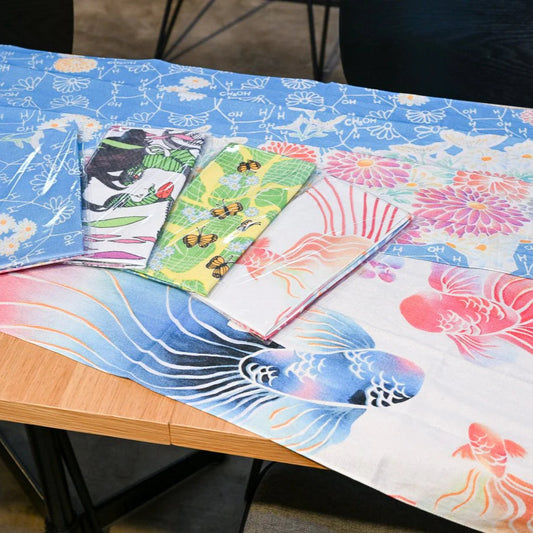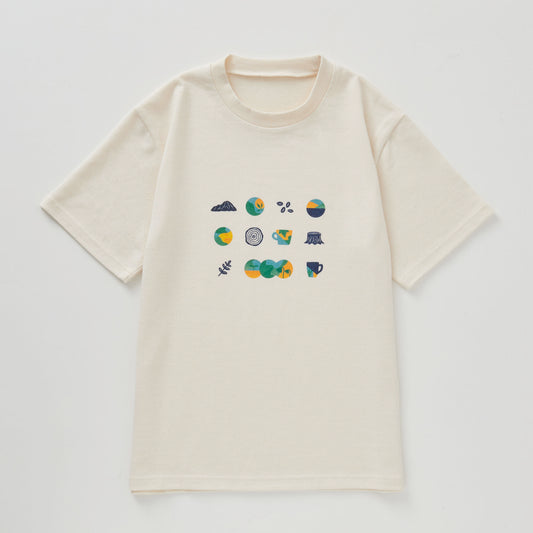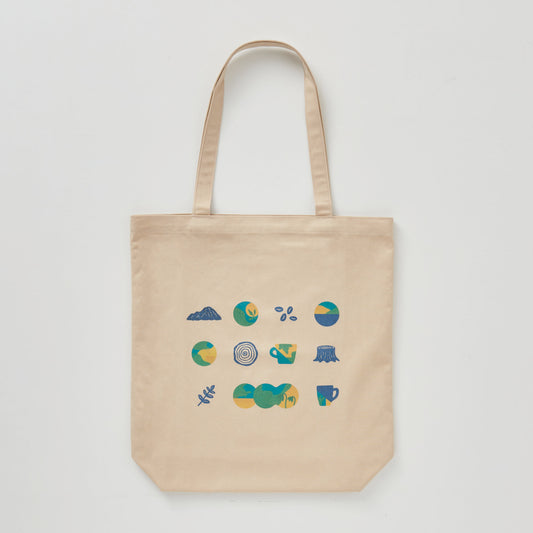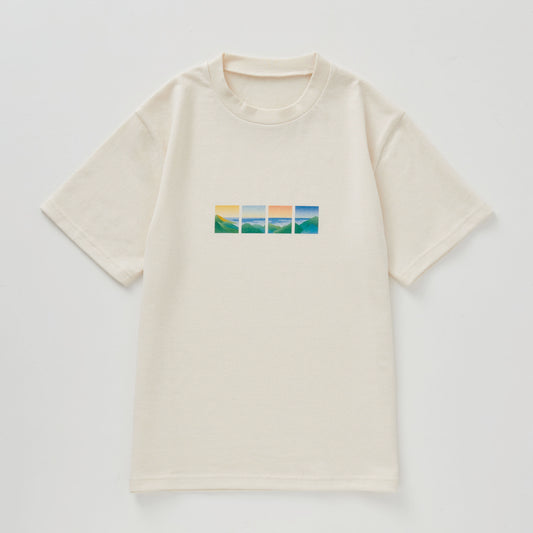Inheriting the techniques and building a new tradition of Yuzen
The history of Kaga Yuzen dates back about 500 years to the unique dyeing technique of "umezome" in Kanazawa, Ishikawa Prefecture. In the mid-17th century, a delicate pattern dyeing style called Kaga-gokuzome was established.
The foundation of Kaga Yuzen was established when it was fused with the designs of Miyazaki Yuzensai, a fan painter who was popular in Kyoto during the Genroku period of the Edo period.
At its peak, there were more than 350 artists, but the number is currently shrinking due to a lack of successors and other factors, and it is an urgent task to pass on the techniques that have been cultivated up to now to the next generation.

■“Kaga Yuzen” A collaboration to connect traditional techniques and the global environment to the next generation
In order to pass on the traditional techniques of Kaga Yuzen to the next generation, a collaboration with Yuzen artist Hitoshi Maita of Maita Somega Kogei has been decided upon from June 2023.
Under the supervision of Mr. Maita, a project has been launched in which students from Kyoto Seika University, who will lead the next generation, will create original designs and Yuzen dyeing techniques to produce "tenugui," a traditional Japanese item that has been a necessity since ancient times.

Kaga Yuzen is characterized by its colors based on the five colors of Kaga - indigo, magenta, ochre, green and ancient purple - and painterly patterns with realistic floral motifs.
In addition, techniques such as "mushikui" (mushi-eaten) which depicts the appearance of leaves eaten by insects, and "saki-bokashi" (blurred edge) which creates a three-dimensional effect in the design are used. It differs from Kyo-Yuzen in that it uses almost no decoration such as gold leaf, tie-dyeing, or embroidery in the finishing process, and depicts the beauty of nature using only delicate dyeing techniques. 
"Blurred tip" "Bug-eaten" 
(Color image source: Kaga Dye Promotion Association http://www.kagayuzen.or.jp/)
We use modern Yuzen dyeing techniques in our design and dyeing.
In addition to the calm, realistic floral patterns typical of Kaga Yuzen, works with a modern twist that reflects the sensibilities of the younger generation are also attracting attention.

■About the design
Reincarnation (by Yuiko Kikuchi)

The paper thread produced is made from discarded paper resources and thinning materials, and it felt as if it was revolving around the main component, cellulose.
From there, he took the theme of "reincarnation" and incorporated into the design a plant of the Asteraceae family, which is often used as a motif in Yuzen and whose flowers represent "reincarnation, rebirth."
A world spun with paper thread (by Noa Maeda)

This time, the image focuses on improving marine pollution, as creatures become more beautiful thanks to the enriched environment created by upcycling.
The colors and thread patterns unique to Yuzen dyeing are linked with the image of a beautiful future and paper thread.
Cycle of... (by Hinata Kameda)

We hope that upcycling will lead to a reduction in plastic, improve air, soil and water pollution, and create a rich and beautiful environment where various living things can live comfortably.
Symbiosis (by Rehman Sadiqa)

It combines two SDGs: coexistence with nature and genderlessness.
Instead of towels or furoshiki, tenugui can be used as a fashion item or a gift, and are integrated into everyday life.





■About Maita Dyeing Crafts
Maita Senga Kogei considers traditional crafts not to be "old things" but to be "an accumulation of fashion that continues to the present day." Using traditional techniques that have been preserved for three generations, the company continues to challenge itself to incorporate the essence of Kaga Yuzen into various creative works other than kimono, such as Western clothing, product packaging, and architectural decoration.

Hitoshi Maita
Full member of the Japan Crafts Council / Director of the Cooperative Kaga Dye Promotion Association / Director of the General Incorporated Association Kaga Yuzen Cultural Association / Part-time lecturer at Kyoto Seika University. He creates kimonos with designs that combine the natural beauty of Kaga Yuzen with geometric patterns.
It combines traditional Yuzen techniques with a unique resist dyeing technique.
We work on a variety of projects, including fashion, interior decoration, and packaging, utilizing the techniques and designs of Kaga Yuzen.
■ An "integrated production system" that brings out the best in artists' designs
Kaga Yuzen involves about 12-15 steps from design to finishing, all of which are done by skilled hands. The dyeing process has traditionally been divided into separate tasks, but at Maita Senga Kogei, we carry out the entire process in our studio. This allows our artists to improve the quality of their work and be responsible for ensuring that designs that are in line with the times are strictly monitored all the way to the final finish.
-
1. Design creation
I create images by turning the beauty of nature and the emotions I feel from it into patterns. I draw full-scale designs on paper, keeping in mind how the garment will look when worn. For special orders, I will create the composition with the requested colors and motifs.

-
2. Temporary tailoring
The white fabric is sewn into the shape of a kimono. For special orders, we will sew a kimono according to the measurements of the person who will wear it.
-
3. Sketch
A temporary white cloth is laid over the design, and the pattern is transferred onto it using the juice of the dayflower, known as "blue flower." Blue flower has the property of disappearing when exposed to water, so it will disappear in the later process.

-
4. Placing the glue
A paste made from steamed glutinous rice flour is squeezed into a paper tube and drawn in thin strips along the lines of the sketch. This is called "itome-nori" and acts as a barrier to prevent the dye from bleeding out in the next process.
-
5. Ground-laying
Soybean juice is brushed onto the back of the fabric. This helps prevent the dye from bleeding and also helps the blue floral design to disperse and disappear.
-
6. Coloring
This is the core process of Kaga Yuzen production, where various colors are applied inside the outline that has been coated with paste using a brush or paintbrush. This is where the beauty and dignity of the finished product is determined, so it requires high skill and a sense of color.

-
7. Pre-steaming
The cloth is placed in a steam box and steamed for several minutes to set the color.
-
8. Filling in the gaps
This is also called "nori-fuse" and involves covering the colored parts with glue to prevent the color from seeping in when the base color is dyed in the next process.

-
9. Ground dyeing
Also known as "hikizome," this is the process of dyeing the base color of a roll of cloth using a brush. To dye evenly, the amount of dye that is soaked in the brush and the force with which the brush is moved must be consistent, requiring concentration and skill.

-
10. Honmushi
The cloth is placed in a steam box and steamed for several minutes to fix the dye.
-
11. Washing with water
This is the process of washing away the thread paste, the blind paste and excess dye with running water. The "Yuzen Nagashi" ritual of washing rolls of cloth in natural rivers was once a seasonal tradition in Kanazawa. Today, most washing is done in artificial rivers with stable water temperature and quality.
-
12. Finishing touches
The fabric is then finished through a process called "steaming," in which steam is used to even out the grain and width, a top finish using pigments, and dye correction.

-
13. Tailoring
From design to finishing, everything is done by skilled hands. It takes several months to make a normal kimono, and up to a year to complete a single piece.

Kaga Yuzen Long-sleeved Kimono by Hitoshi Maita




